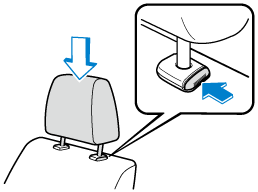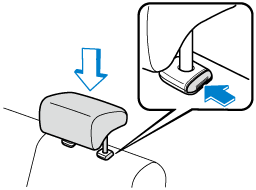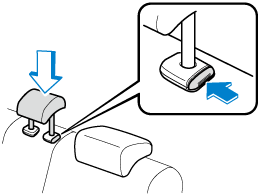Seats
Seat Precautions
Make sure the adjustable components of a seat are locked in place:
Adjustable seats and seatbacks that are not securely locked are dangerous. In a sudden stop or collision, the seat or seatback could move, causing injury. Make sure the adjustable components of the seat are locked in place by attempting to slide the seat forward and backward and rocking the seatback.
Never allow children to adjust a seat:
Allowing children to adjust a seat is dangerous as it could result in serious injury if a child's hands or feet become caught in the seat.
Do not drive with the seatback unlocked:
All of the seatbacks play an important role in your protection in a vehicle. Leaving the seatback unlocked is dangerous as it can allow passengers to be ejected or thrown around and baggage to strike occupants in a sudden stop or collision, resulting in severe injury. After adjusting the seatback at any time, even when there are no other passengers, rock the seatback to make sure it is locked in place.
Adjust a seat only when the vehicle is stopped:
If the seat is adjusted while the vehicle is being driven, the seating posture may become unstable and the seat could move unexpectedly resulting in injury.
Do not modify or replace the front seats:
Modifying or replacing the front seats such as replacing the upholstery or loosening any bolts is dangerous. The front seats contain air bag components essential to the supplementary restraint system. Such modifications could damage the supplementary restraint system and result in serious injury. Consult an Authorised Mazda Repairer if there is any need to remove or reinstall the front seats.
Do not drive with damaged front seats:
Driving with damaged front seats, such as seat cushions torn or damaged down to the urethane, is dangerous. A collision, even one not strong enough to inflate the air bags, could damage the front seats which contain essential air bag components. If there was a subsequent collision, an air bag may not deploy which could lead to injuries. Always have an Authorised Mazda Repairer inspect the front seats, front seat belt pretensioners and air bags after a collision.
Do not drive with either front seats reclined:
Sitting in a reclined position while the vehicle is moving is dangerous because you do not get the full protection from seat belts. During sudden braking or a collision, you can slide under the lap belt and suffer serious internal injuries. For maximum protection, sit well back and upright.
Do not place an object such as a cushion between the seatback and your back:
Putting an object such as a cushion between the seatback and your back is dangerous because you will be unable to maintain a safe driving posture and the seat belt cannot function at its full capacity in a collision, which could result in a serious accident, injury or death.
Do not place objects under the seat:
The object could get stuck and cause the seat to not be fixed securely, and result in an accident.
Do not stack cargo higher than the seatbacks:
Stacking luggage or other cargo higher than the seatbacks is dangerous. During sudden braking or a collision, objects can fly around and become projectiles that may hit and injure passengers.
Make sure luggage and cargo is secured before driving:
Not securing cargo while driving is dangerous as it could move or be crushed during sudden braking or a collision and cause injury.
Never allow a passenger to sit or stand on the folded seatback while the vehicle is moving:
Driving with a passenger on the folded seatback is dangerous. Allowing a child to sit up on the folded seatback while the vehicle is moving is particularly dangerous. In a sudden stop or even a minor collision, a child not in a proper seat or child-restraint system and seat belt could be thrown forward, back or even out of the vehicle resulting in serious injuries or death. The child in the baggage area could be thrown into other occupants and cause serious injury.
-
When operating a seat, be careful not to put your hands or fingers near the moving parts of the seat or on the side trim to prevent injury.
-
When moving the seats, make sure there is no cargo in the surrounding area. If the cargo gets caught it could damage the cargo.
-
(Manual Seat)
When moving the seats forward and rearward or returning a rear-reclined seatback to its upright position, make sure you hold onto the seatback with your hand while operating. If the seatback is not held, the seat will move suddenly and could cause injury.
-
When returning a rear seat to its original position, place the seat belt in its normal position. Verify that the seat belt pulls out and retracts.
-
(Power Seat)
The seat-bottom power adjustment is operated by motors. Avoid extended operation because excessive use can damage the motors.
-
To prevent the battery from running down, avoid using the power adjustment when the engine is stopped. The adjuster uses a large amount of electrical power.
-
Do not use the switch to make more than one adjustment at a time.
-
-
When getting in and out of the vehicle, your foot could accidentally contact the seat height adjustment lever and cause the seat to lower.
Adjust the seat to obtain the correct driving position.
Front Seat
Seat Operation

 Seat Slide
Seat Slide
(Manual Seat)
To move a seat forward or backward, raise the lever and slide the seat to the desired position and release the lever.
Make sure the lever returns to its original position and the seat is locked in place by attempting to push it forward and backward.
(Power Seat)
To slide the seat, move the slide lifter switch on the outside of the seat to the front or back and hold it. Release the switch at the desired position.
 Height Adjustment (Some Models)
Height Adjustment (Some Models)
(Manual Seat)
To adjust the seat height, move the lever up or down.
(Power Seat)
To adjust the seat height, move the switch up or down.
 Height Adjustment for Front Edge of Seat Bottom (Driver's Power Seat)
Height Adjustment for Front Edge of Seat Bottom (Driver's Power Seat)
To adjust the front height of the seat bottom, raise or lower the front of the slide lifter switch.
 Seat Recline
Seat Recline
(Manual Seat)
To change the seatback angle, lean forward slightly while raising the lever. Then lean back to the desired position and release the lever.
Make sure the lever returns to its original position and the seatback is locked in place by attempting to push it forward and backward.
(Power Seat)
To change the seatback angle, press the front or rear side of the reclining switch. Release the switch at the desired position.
 Lumbar Support Adjustment (Driver's Power Seat)
Lumbar Support Adjustment (Driver's Power Seat)
To increase the seat firmness, press and hold the front part of the switch to the desired position, then release it.
Press the rear part of the switch to decrease firmness.
Seat Warmer (Some Models)
The front seats are electrically heated. The ignition must be switched ON.
Press the seat warmer switch while the ignition is switched ON to operate the seat warmer. The indicator lights turn on to indicate that the seat warmer is operating. The mode changes as follows each time the seat warmer switch is pressed.
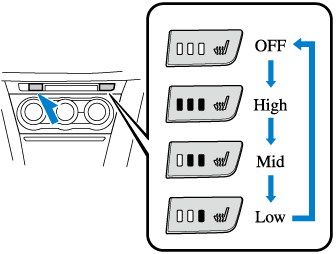
Be careful when using the seat warmer:
The heat from the seat warmer may be too hot for some people, as indicated as follows, and could cause a low-temperature burn.
-
Infants, small children, elderly people, and physically challenged people
-
People with delicate skin
-
People who are excessively fatigued
-
People who are intoxicated
-
People who have taken sleep-inducing medicine such as sleeping pills or cold medicine
Do not use the seat warmer with anything having high moisture-retention ability such as a blanket or cushion on the seat:
The seat may be heated excessively and cause a low-temperature burn.
Do not use the seat warmer even when taking a short nap in the vehicle:
The seat may be heated excessively and cause a low-temperature burn.
Do not place heavy objects with sharp projections on the seat, or insert needles or pins into it:
This could cause the seat to become excessively heated and result in injury from a minor burn.
Do not use organic solvents to clean the seat. It may damage the seat surface and the heater.
-
If the ignition is switched off while the seat warmer is operating (High, Mid or Low) and then switched ON again, the seat warmer will automatically operate at the temperature set before switching off the ignition.
-
Use the seat warmer when the engine is running. Leaving the seat warmer on for long periods with the engine not running could cause the battery power to be depleted.
-
The temperature of the seat warmer cannot be adjusted beyond High, Mid and Low because the seat warmer is controlled by a thermostat.
Driving Position Memory (Some Models)
The desired driving position can be called up after programming the position.
The following driving positions can be programmed.
-
Driver’s seat position (seat slide, height adjustment, front edge of seat bottom, seat recline)
Refer to Seat Operation (Search).
-
Active driving display (display position, brightness level, display information)
Refer to Active Driving Display (Search).
Do not place fingers or hands around the bottom of the seat while the seat memory function is operating. The seat moves automatically while the seat memory function is operating and fingers or hands could get pinched and injured.
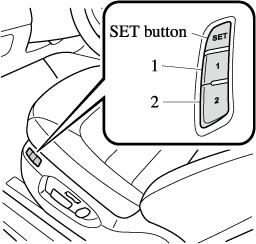
A driving position can be programmed or operated using the buttons on the side of the seat or the key.
-
Lumbar support adjustment cannot be programmed.
-
A driving position can be programmed to the buttons on the side of the seat and the key in use for driving the vehicle.
-
If the vehicle has been serviced and the battery leads disconnected, the programmed seat positions will have been erased. Re-programme the seat positions.
Programming
-
Make sure the parking brake is on.
-
(Automatic transaxle)
Make sure the selector lever is in the P position.
-
Start the engine.
-
Adjust the seat and the active driving display to the desired driving position.
-
Press the SET button on the seat until a beep sound is heard 1 time.
-
Perform one of the following settings within 5 seconds of completing step 5 above:
-
Programming using a button on the side of the seat
Press the button you want to programme, either button 1 or 2, until a beep sound is heard 1 time.
-
Programming using the key
Press the key
 button until a beep sound is heard 1 time.
button until a beep sound is heard 1 time.
-
To move the driving position to a programmed position
(Using a button on the side of the seat)
-
Make sure the parking brake is on.
-
(Automatic transaxle)
Make sure the selector lever is in the P position.
-
Start the engine.
-
Press the programming button for the driving position you want to call up (button 1 or 2).
-
A beep sound is heard when the driving position adjustment is completed.
-
If the driving position movement is not changed, only the beep sounds.
-
A seat position can be called up even with the engine not running.
-
The driving position adjustment is cancelled in the following cases:
-
Any of the seat adjustment switches is operated.
-
The SET button is pressed.
-
Programming button 1 or 2 is pressed.
-
The key
 button or
button or  button is operated.
button is operated. -
The vehicle starts moving.
-
The active driving display is adjusted.
-
(Using a programmed key)
-
Unlock the doors by pressing a request switch or the key
 button.
button. -
After unlocking the doors, the seat position adjustment begins within 40 seconds of opening the driver's door, and a beep sounds when the operation is finished.
-
Make sure the parking brake is on.
-
(Automatic transaxle)
Make sure the selector lever is in the P position.
-
Start the engine.
-
The active driving display adjustment begins.
-
If there is no driving position movement, a beep is not heard.
-
The driving position adjustment is cancelled in the following cases:
-
Any of the seat adjustment switches is operated.
-
The SET button is pressed.
-
Programming button 1 or 2 is pressed.
-
The key
 button or
button or  button is operated.
button is operated. -
The vehicle starts moving.
-
The active driving display is adjusted.
-
Erasing programmed driving positions
(Erasing the driving positions programmed to the key)
-
Switch the ignition OFF.
-
Press the SET button on the side of the seat until a beep sound is heard 1 time.
-
After the beep sounds, press the key
 button within 5 seconds until a beep sound is heard 1 time.
button within 5 seconds until a beep sound is heard 1 time.
Rear Seat
Split Folding the Seatbacks
By lowering the rear seatbacks the luggage compartment space can be expanded.
Do not drive the vehicle with occupants on folded down seatbacks or in the luggage compartment.
Putting occupants in the luggage compartment is dangerous because seat belts cannot be fastened which could lead to serious injury or death during sudden braking or a collision.
Do not allow children to play inside the vehicle with the seatbacks lowered.
Allowing children to play in the vehicle with the seatbacks folded down is dangerous. If a child enters the luggage compartment and the seatbacks were raised back up, the child may become trapped in the luggage compartment which could lead to an accident.
Tightly secure cargo in the luggage compartment when it is transported with the seatbacks folded down.
Driving without tightly securing cargo and luggage is dangerous as it could move and become an obstruction to driving during emergency braking or a collision resulting in an unexpected accident.
When transporting cargo, do not allow the cargo to exceed the height of the seatbacks.
Transporting cargo stacked higher than the seatbacks is dangerous as visibility to the rear and sides of the vehicle is reduced which could interfere with driving operations and lead to an accident.
Lowering the seatbacks
-
When folding the seatback forward, always support the seatback with your hand. If it is not supported by a hand, fingers or the hand pressing the push knob could be injured.
-
Check the position of a front seat before folding a rear seatback.
Depending on the position of a front seat, it may not be possible to fold a rear seatback all the way down because it may hit the seatback of the front seat which could scratch or damage the front seat or its pocket. Remove the head restraint on the rear outboard seat if necessary.
-
Before folding a rear seatback, make sure that the armrest is stored. If a seatback is lowered without storing the armrest, it could deform, damage, or scratch the armrest.
-
Lower the head restraint all the way down.
Refer to Head Restraints (Search).
-
Press the push knob to fold down the seatback.
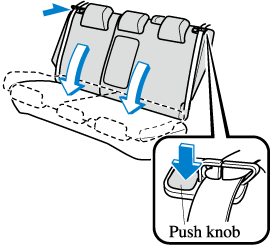
To return the seatback to its upright position:
When returning a seatback to its upright position, make sure the 3-point seat belt is not caught in the seatback and the 3-point seat belt is not twisted.
If the seat belt is used while it is twisted and caught in the seatback, the seat belt cannot function at its full capacity, which could cause serious injury or death.
When returning a seatback to its upright position, make sure that it is firmly locked and the red indication is not visible.
If the red indication is visible behind the push knob, it means the seatback is not locked. If the vehicle is driven without the seatback locked, it could fold down suddenly and cause an accident.

-
Make sure that the seat belt passes through the seat belt guide correctly and it is not twisted, then raise the seatback while preventing the seat belt from being caught in the seatback.
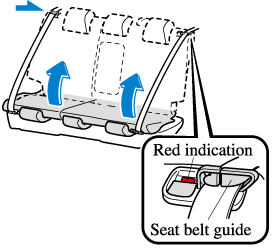
-
Press the seatback rearward and lock it in place. After returning the seatback to its upright position, make sure it is securely locked.
Armrest (Some Models)
The rear armrest in the centre of the rear seatback can be used (no occupant in the centre seat) or placed upright.

Never position the shoulder portion of a seat belt over the armrest:
Positioning the shoulder portion of a rear seat belt over the armrest is dangerous as it cannot provide adequate protection in a collision and could result in serious injuries.
Never put your hands and fingers around the moving parts of the seat and armrest:
Putting your hands and fingers around the moving parts of the seat and armrest is dangerous as they could get injured.
-
Be careful not to apply excessive force to the armrest such as by sitting on it. Otherwise, it could be deformed or damaged.
-
When storing the armrest, return the cup holder to its original position. If the armrest is stored without returning the cup holder to its original position, the cup holder could be deformed or damaged.
Head Restraints
Your vehicle is equipped with head restraints on all outboard seats and the rear centre seat. The head restraints are intended to help protect you and the passengers from neck injury.
Always drive with the head restraints installed when seats are being used and make sure they are properly adjusted. In addition, always raise the head restraints on all rear seats when they are being used:
Driving with the head restraints adjusted too low or removed is dangerous. With no support behind your head, your neck could be seriously injured in a collision.
Height Adjustment
Removal/Installation
To remove the head restraint, pull it up while pressing the stop-catch.
To install the head restraint, insert the legs into the holes while pressing the stop-catch.
Always drive with the head restraints installed when seats are being used and make sure they are properly installed:
Driving with the head restraints not installed is dangerous. With no support behind your head, your neck could be seriously injured in a collision.
After installing a head restraint, try lifting it to make sure that it does not pull out:
Driving with an unsecured head restraint is dangerous as the effectiveness of the head restraint will be compromised which could cause it to unexpectedly detach from the seat.
-
When installing a head restraint, make sure that it is installed correctly with the front of the head restraint facing forward. If the head restraint is installed incorrectly, it could detach from the seat during a collision and result in injury.
-
The head restraints on each of the front and rear seats are specialized to each seat. Do not switch around the head restraint positions. If a head restraint is not installed to its correct seat position, the effectiveness of the head restraint during a collision will be compromised which could cause injury.





















































